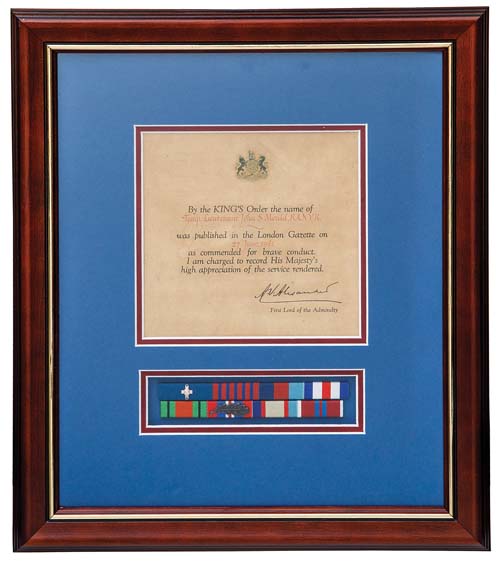Australian Singles
Lot 4022 SESSION 10 (9.30AM FRIDAY 27TH NOVEMBER) Australian Singles
Estimate $2,000
Bid at live.noble.com.au
COMMENDATION FOR BRAVE CONDUCT CERTIFICATE, named to Temp. Lieutenant John S.Mould, R.A.N.V.R., published in LG on 27 June, 1941, mat framed and below this, also mat framed, a copy of his ribands that include George Cross with emblem, George Medal, 1939-45 Star, France and Germany Star, Defence Medal 1939-45, War Medal 1939-45 with MID, Australia Service Medal 1939-45, Coronation Medal 1953, all the above under Perspex in a timber frame (33.2x39.5cm). Uncirculated.
The Commendation for Brave Conduct was originally in the form of a card certificate as in this lot. From 1943 a pin-back plastic badge was initiated for civilian recipients and from 1946 this was replaced by a silver metal laurel leaf for civilians and a bronze oak leaf issued to armed forces personnel including merchant seamen.
Lieutenant Commander Mould's group of eight medals were sold by his family after his death in 1957. They were then auctioned in Brisbane in 2004 for a world record price of $440,000 to a private Brisbane investor.
John Stuart Mould, naval officer and architect, was born on 21 March 1910 at Gosforth, Northumberland, England, His family emigrated to Australia when he was only two years old. He was educated at Sydney Grammar School and then attended university in London and on graduation became an associate of the Royal Institute of British Architects in 1934. He then returned to Sydney and joined his father in private practice.
On 14 June 1940 John Mould enlisted in the 2/AIF. He contracted bronchial pneumonia and, while recuperating, he qualified through the Yachtsmen Scheme for appointment as sub lieutenant, Royal Australian Naval Volunteer Reserve. He discharged from the AIF and was mobilized in the RANVR on 14 September 1940 and sent to England for training at HMS King Alfred. Along with Hugh Syme, H.D. Reid and J.H.H. Kessack, he volunteered for 'special duties ashore'-service in the Royal Navy's specialist section, Rendering Mines Safe. He was provisionally promoted lieutenant in December 1940 and posted to HMS Vernon.
The RMS section had been established to assist in disarming the large number of unexploded bombs and mines spread across Britain by German aircraft. Although most of the work involved bombs, the RMS's naval personnel were primarily concerned with 'delousing' German sea mines which had been dropped on land or washed ashore. John Mould performed outstanding work on dock clearance operations and those resulting in the stripping of the early German mine Type G. He received a commendation for bravery in June 1941 (the above certificate) and was awarded the George Medal in April 1942.
Among numerous assignments, Mould recovered, rendered safe and investigated the first German magnetic acoustic unit and moored magnetic mine. The successful dismantling of such weapons allowed British scientists to identify their triggering mechanisms and thus devise countermeasures. In addition to the usual hazards of handling explosives, Mould and his colleagues had to contend with booby traps set to detonate the mines if attempts were made to disarm and disassemble them. In November 1942 he was awarded the George Cross for 'great gallantry and devotion to duty'.
Promoted acting lieutenant commander in January 1943, he began work with Professor Jack Haldane to develop a diving-suit with an independent air supply. Later that year Mould, together with Lieutenant Leon Goldsworthy, RANVR, and Lieutenant Commander J. L. Harries, Royal Canadian Navy, trained groups of men known as 'P' parties in preparation for the invasion of Western Europe. These units were intended to be dispatched to newly captured harbours to clear them of booby traps, mines and other obstructions. Mould was given the opportunity to command one of the parties but instead chose to continue training men who would serve in them.
After the German surrender in May 1945, Mould was sent to Ceylon and Australia to assess the need for 'P' parties in the Far East and Pacific theatres and was assigned as commander of two of the parties about the time that World War II ended. Mould's RANVR appointment terminated on 26 November 1945 while he was in Britain and he got a position as an architect with the allied military government in Germany and helped with that country's reconstruction.
John Mould returned to Australia in 1948 and after working as an architect with the Department of Public Works, he was appointed chief architect to the Housing Commission of New South Wales in 1950. He died of peritonitis on 9 August 1957 in Royal North Shore Hospital and was cremated at the Northern Suburbs Memorial Gardens and Crematorium at North Ryde where he is commemorated by a plaque in the RSL Section.
Estimate / sale price does not include buyer's premium (currently 22% including GST) which is added to hammer price. All bids are executed on the understanding that the Terms & Conditions of sale have been read and accepted. For information on grading and estimates please refer to the Buying at Auction advice.
Quick find
View a lot by number and sale.
Adjacent lots
Lot 4020
MOTHER'S AND WIDOW'S RIBBON (AIF), one star, number 11805 on reverse of suspension bar. Side ...
Estimate $100
Lot 4021
ANZAC COMMEMORATIVE MEDALLION, 1915, issued in 1967, in bronze (50x75mm) (C.1915/3), named to E.A.W.Clarke. Uncirculated. ...
Estimate $200
Lot 4022 This lot
COMMENDATION FOR BRAVE CONDUCT CERTIFICATE, named to Temp. Lieutenant John S.Mould, R.A.N.V.R., published in LG ...
Estimate $2,000
Lot 4023
WAR MEDAL 1939-45. VX101034 J.F.Walsh. Impressed. Very fine.
Estimate $150
Lot 4024
SINGLE MEDAL TO KIA: War Medal 1939-45. NX40901 J.D.A.Waygood. Impressed. Very fine.
Estimate $170
